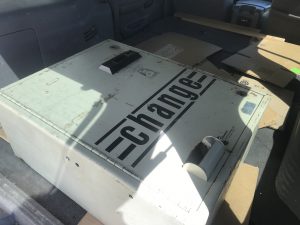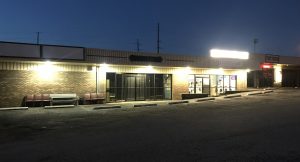Making The AC More Efficient
Air Conditioner Issues
Recently we have been having some issues with the AC unit kicking out. So I needed to come up with a way to make it through the hot days until we can come up with a permanent plan.
Let me give you some history. When I first took over the store about 4 years ago the previous owner did not run the air conditioning. The excuse I got was that the landlord would not fix the system. Once I started renovating I approached the landlord about fixing the system so he called in a service tech.
The furnace and AC were original to the building and around 40? years old.
(This picture is from another unit in the same building). This one is still running.
They tried to do CPR on the AC outdoor unit but it was not to be. The original system consisted of a 24” square filter opening, about 12” of the duct, the propane furnace, the AC coil, about 2 more feet of duct and a vent opening (all in the ceiling).
Over the next few weeks, the AC company stopped by a few times to check the system and do some measurements etc. Their original plan was to install new duct work with distribution around the outsides of the room and use the existing inlet by the dryers and install a new heat pump. But the cost was too high and “the furnace still worked” so the duct work and new AC was installed.
After a few headaches due to the technician’s gauge not being calibrated so the pressures were not right and the AC would kick out on hot days, we were cooling.
The next fall, after I had switched all the dryers to Natural Gas (I’ll cover that fiasco in another post) I called the HVAC company to switch over the furnace. They referred me to a plumber as they didn’t have a propane license. The plumber showed up, said it had originally been gas before it was converted to propane but the company didn’t make the conversion kit anymore so it couldn’t be switched back.
So I had a propane tank re-installed and spent about $300 on a new pipe from the tank to the furnace.
After a couple of summers of not being able to keep up with the cooling due to the old furnace not being able to move enough air through the newly expanded duct work and I had had enough of the propane tank I decided to install a new furnace.
I explained the problems to an HVAC contractor I had used before and said I needed airflow and lots of it. He came up with a price and said he would make it happen.
The old furnace was removed and a new one installed. As much as it didn’t have the airflow I was hoping, it did manage to move the air through the store and maintain a stable temperature so it was OK. Also the there was no more propane to deal with.
Now back to the summer AC issues. Once we hit the hot days in the summer we had the AC kick out a couple of times. We change the filters regularly and did miss once which caused a problem. Part of the weekly check list is to turn the power off to the AC unit and hose down the coils to clean out any lint from the dryer vents.
On the 90+ days, we had an issue again. Now the outdoor unit is on the South side of the building so that isn’t helping.
As you can see in the video I used a temperature sensor (you can buy a similar one by clicking here) to check the air coming out of the fan in the outdoor unit.
A stable 150 degrees F. Too hot to hold your hand over for any length of time.
Based on my experience in cooling towers and heat transfer I had previously misted water from a hose on to the fins on the side of the AC to help cool the unit so I thought “ Why not something a little more permanent?”
I tried a soaker hose wrapped around the unit and it dropped the temperature from 150 to 128.
Once I found that would work I picked up some parts to make it an easier system to use. The parts were from a mini irrigation system from one of the big box stores. The whole system cost less than $25 and is turned on from a spare valve in the store.
I have also installed an inside/outside thermometer to monitor the duct temperature. The “outside” sensor is in one of the supply vents so if the store temp starts to go up the attendants can see if the AC is keeping up or if the water needs to be turned on to the sprays.
At this point is not an automatic system and it gets left one occasionally but it only uses about 20 gallons a day. It adds up but in my area, water rates are cheaper than power rates and it’s only used about a dozen days a year.
There are some things to consider if you are looking at this. Unless your water is very pure or filtered impurities will build up on the fins as the water evaporates. It will need to be monitored and cleaned to prevent premature failure of the unit.
The funny part about this building is that the unit my storage and office are in beside the laundry has the newest HAVC in the building and it will blow paper off my desk when it starts.
There is a good chance I will re-duct some of this unit to the laundry and set a separate thermostat about 3 degrees higher than the main one so I can use this unit to support on the hot, busy days.
Take these lessons from this when you are renovating or negotiating a lease. The cost to run Heat and AC in your laundry can have a big impact on your power/gas bills if they are not sized correctly.
If you have any comments please post them below.
Ken





